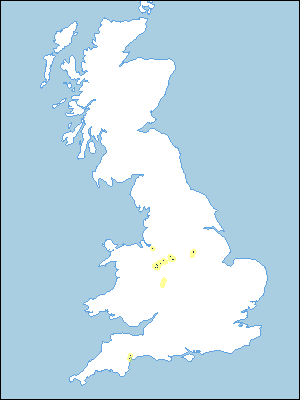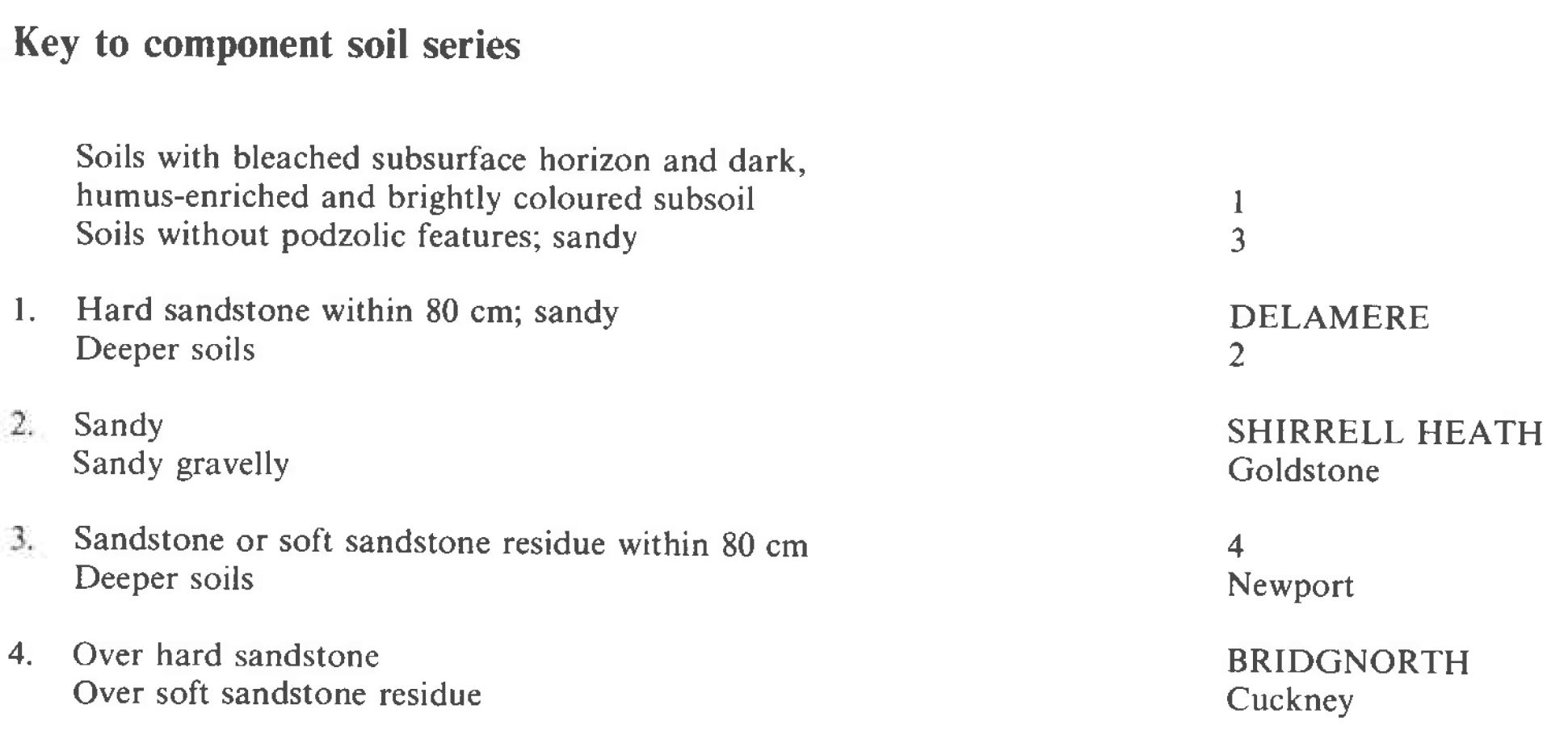
Soil Associations
0631b DELAMERE
Soil and site characteristics
Well drained sandy soils commonly with a bleached subsurface horizon over sandstone. Occasional deeper soils. Very acid where uncultivated.
Geology
Permo-Triassic reddish sandstone
Cropping and Land Use
Coniferous woodland and lowland heath habitats; some cropping.
Component soil series
| Subgroup | Series name | Percentage | WRB 2006 link |
|---|---|---|---|
| 6.31 | DELAMERE | 50% | Endoleptic Albic Podzols |
| 5.51 | BRIDGNORTH | 15% | Arenic Endoleptic Regosols |
| 6.31 | SHIRRELL HEATH | 15% | Albic Podzols |
Covers 79 km2 in England and Wales
Soilscapes Classification
| 14 |
Freely draining very acid sandy and loamy soils |
0631b DELAMERE
Detailed Description
The Delamere association consists mainly of well drained very acid sandy soils, developed in reddish Permo-Triassic or locally Carboniferous sandstone. It is mostly under woodland or lowland heath, and is inextensive, covering only 80 km², mainly in Cheshire, Shropshire, Staffordshire and Nottinghamshire with a small area in Devon. Slopes are usually moderate and altitudes range from 60 to 220 m O.D. Humo-ferric podzols of the Delamere series which have extremely porous sandy profiles overlying hard sandstone are the predominant soils. The main associate soils, the Bridgnorth series, are typical brown sands developed in the same parent material. Soils of the Shirrell Heath and Cuckney series occur where the parent sandstone is soft and weakly consolidated. The Shirrell Heath soils are deep humo-ferric podzols which were formerly included in the Delamere series by King (1977) and Hollis (1978). Goldstone series is found where the sandstone is pebbly and there are Redlodge and Newport soils in local pockets of thick sandy drift. The soils are found mainly in Staffordshire and north-east Shropshire but also occur in Delamere Forest and to the south and east of Mansfield. Near Kinver and Enville, the association is dominated by the Delamere series with Goldstone soils on pebbly facies within the sandstone of minor importance only. South of Loggerheads and in Bishop's Wood further south, drift is more extensive than elsewhere and Redlodge soils are an important subsidiary. Goldstone soils are common on outcrops of conglomerate and rare inclusions of the Lydcott series, ferric stagnopodzols, are found in wet hollows. On steep slopes of the Churnet valley south of Oakamoor, Bridgnorth soils occur on the lower ground and shallow Newtondale soils (Carroll and Bendelow 1981) fringe rock outcrops on the steepest slopes. North of Oakamoor, the soils are on coarse reddish Rough Rock and Chatsworth Grit of the Millstone Grit formation, and the main subsidiary soils are Anglezarkeand Lydcott series. In the Tern valley between Crudgington and Market Drayton and in the Trent valley north of Stone, the association is extensive on former heaths now reclaimed for agriculture. Here Bridgnorth soils are more common than elsewhere and there is widespread drift giving Redlodge and Newport soils, the former occurring mainly under woodland or heath. In addition to Shirrell Heath soils, the Cuckney series is found on soft sandstones. In Delamere Forest, Delamere and Shirrell Heath profiles predominate with Redlodge soils in local pockets of drift. Wet hollows are more common than elsewhere giving seasonally waterlogged soils of the Blackwood and Reaseheath series, and Ridley soils occur where thick peat has accumulated. Around Mansfield, the Shirrell Heath series is often dominant and there are occasional Cuckney and Howard soils. The association covers only 3 km² south of Exeter.
Soil Water Regime
These well drained permeable sandy soils are seldom wet (Wetness Class I) and readily accept winter rainfall even on steep slopes.
Cropping and Land Use
Much land is under woodland, the remainder being mostly under semi-natural lowland heath. Small areas around the woodlands have been cleared for agriculture. Coniferous or mixed-coniferous plantations, managed largely by the Forestry Commission, are usual but in the few private woodlands there are occasional stands of deciduous trees grown for special uses or retained for their amenity. In south Staffordshire, Scots pine is the main species together with some Corsican pine, larch and Western hemlock. Pine and larch grow well in the sandy soils despite the shallow depth to rock. Some red oak and birch are intermingled with the conifers and occasionally very mature oaks survive on the edge of the forest. To the east of Swynnerton and south of Loggerheads there are dense plantations of Scots pine and larch interspersed with a few broadleaved trees and minor stands of Corsican pine. Around Oakamoor the woodland is less dense and more varied than elsewhere because slopes are steep. Scots pine with birch, beech and wych elm (often by regeneration) are the main species. Red oak is sometimes planted with a coniferous nurse species, and there is some Corsican pine, Lodgepole pine, larch and Western hemlock. Where the canopy is more open, bracken and, to a lesser extent, rhododendron form a dense undergrowth with thickets of hazel and rowan adding to the variety. Clipstone Forest in Nottinghamshire is mainly Corsican pine but Delamere Forest in Cheshire has a similar composition to the plantations of south Staffordshire with some pure deciduous stands preserved on the periphery of the main wood. Highgate Common in south Staffordshire is a good example of the lowland heath which develops on these soils under semi-natural conditions. It is dominated by Calluna in association with Nardus, Agrostis and Deschampsia flexuosa; bracken has infested the common to varying degrees and birch trees are widely scattered throughout. Under agriculture, the soils are similar to those of the Bridgnorth association and are used to grow cereals and potatoes. Reserves of available water are small and there is a risk of drought in Nottinghamshire, south Staffordshire and Shropshire, especially for potatoes. The land is easily worked and there are ample opportunities for cultivation particularly in autumn. Topsoils dry rapidly and can be worked soon after heavy rainfall with little risk of structural damage; this is an advantage when growing late harvested crops. Organic matter contents of topsoils are generally larger than those of soils in the Bridgnorth association but these decrease quickly under continuous arable use. Large applications of lime and fertilizers are needed when reclaiming the impoverished land from forest or heath. Subsequent regular applications are needed to maintain fertility as some nutrients are easily leached from these porous soils.
0631b DELAMERE
Distribution Map
 |
Note that the yellow shading represents a buffer to highlight the location of very small areas of the association.
Keys to component soil series
Midlands
 |
All information Copyright, Cranfield University © 2025
Citation: To use information from this web resource in your work, please cite this as follows:
Cranfield University 2025. The Soils Guide. Available: www.landis.org.uk. Cranfield University, UK. Last accessed 25/04/2025
